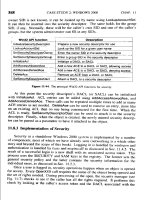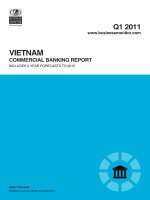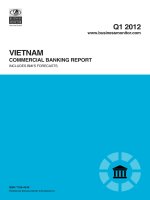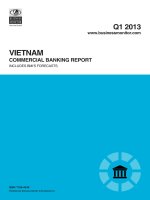Modern commercial banking 2nd
Bạn đang xem bản rút gọn của tài liệu. Xem và tải ngay bản đầy đủ của tài liệu tại đây (1.18 MB, 362 trang )
This page
intentionally left
blank
Copyright © 2008, New Age International (P) Ltd., Publishers
Published by New Age International (P) Ltd., Publishers
All rights reserved.
No part of this ebook may be reproduced in any form, by photostat, microfilm,
xerography, or any other means, or incorporated into any information retrieval
system, electronic or mechanical, without the written permission of the publisher.
All inquiries should be emailed to
ISBN (13) : 978-81-224-2622-9
PUBLISHING FOR ONE WORLD
NEW AGE INTERNATIONAL (P) LIMITED, PUBLISHERS
4835/24, Ansari Road, Daryaganj, New Delhi - 110002
Visit us at www.newagepublishers.com
Dedication
Dedication
To my dear children
Raghu, Suren and Rajasri
who have done me proud by excelling in their chosen fields
This page
intentionally left
blank
PREFACE TO THE SECOND
EDITION
Since the publication of the first edition of this book five years ago several
developments covering the money market, the government securities market
and the foreign exchange market have taken place to strengthen their integration
and enhance their efficiency. Efficient settlement mechanisms, greater
transparency and best market practices are put in place, which facilitate faster
transactions and lower their costs.
Efforts have been concentrated on improving the credit delivery mechanisms.
Although the Narasimhan Committee on the Financial System (1991)
recommended the phasing out of the directed credit programme at 10 per cent of
the bank credit not only the proportion has been retained at 40% level but its
coverage has been considerably enlarged. The appropriate instrument to achieve
distributive justice is fiscal policy not credit policy. Fiscal policy ensures the
scrutiny of budget provision at various levels. Efficiency and economy in the
spending of public money are ensured by the different agencies of financial
control which include the legislature, the Estimates Committee and the Public
Accounts Committee. The audit of the government expenditure prescribed by
the Constitution is to be undertaken by the Comptroller and Auditor General. All
these agencies of control direct their control or review towards ensuring that
money is available for the purpose for which it is spent, that the manner of
expenditure conforms to the manner prescribed by the legislature and full value
is obtained for the money spent. Further, the expenditure is either tax financed
(with no quid pro quo) or by borrowing (revenue expenditure included in fiscal
deficit) with inflationary consequences. While the inflationary impact of
expenditure financed either by credit or budget is common, there are no checks
constitutional or otherwise in the end use of funds in the case of credit.
Directed credit in the name of social banking is extended out of deposits
made by public in trust with banks. While the Banking Regulation Act (BRA)
(viii)
does not envisage protection of depositors interest like the protection of investors
interest by the Securities and Exchange Board of India it requires RBI to have
due regard to the interests of depositors in enunciating banking policy from time
to time. BRA however mentions the need or equitable allocation and efficient
use of deposits. In discussions of credit policy and banking systems, the safety
of deposits which are after all placed with the bank in trust, the phrase depositors
interest does not find any mention. It is indeed perplexing that bank shares
listed on the Stock Exchange do not seen to be analysed by any maximization of
deposit holders’ interests which are used to leverage the activities of the bank
and the effect of directed credit on the erosion of deposits and profitability.
While the requirements of the priority sector lending has been retained at
40 per cent of bank credit, the categories of advances eligible for priority sector
have been expanded to provide banks increased opportunities to lend to these
sectors. The earlier definition of priority sector comprising agriculture, small
industrial units, new entrepreneurs, road and water transport operators, retail
traders, small businessmen, professionals, self-employed, weaker sections has
been extended to include venture capital (for limited time), housing and micro
credit. Under the concept of financial inclusion, pensioners, weaker sections
and groups who were excluded earlier from credit facilities are to be brought
in. The efforts of banks towards financial inclusion will be monitored and
their behaviour reinforced by a system encouragement (incentives for
conformity) and disincentives (penalisation for non conformity).
At the end of March 2005 priority sector advances outstanding were
Rs.3,45,627 crores (37.1% of gross bank credit) and advances for housing
Rs.75,173 crores (8.1%) which together constitute 45.5% of gross bank credit.
The NPAs of priority sector constitute more or less the same proportion of
total NPAs of the banking system. The NPAs of rural cooperative sector add
up to another Rs.20,000 crores. The housing loans under the priority sector
have given rise to land/real estate bubble. Prices have gone up in the last three
years by more than five times.
While financial exclusion is nobody’s case the credit requirements of
individuals/households are mainly for social purposes. Social attitudes towards
expenditures associated with birth, marriage (including dowry) and death have
not changed. People also choose to live on credit by deferring payments to
landlord for housing, milk vendor, provision stores, friends and whatever. As
it is, personal loans amounted to Rs.87,000 crores with banking system in
2003-04. How is the banking system to meet the requirements? To realize
personal loans whatever collateral has been pledged has to be liquidated. Again
loans are preferred to outright sale of collateral in the Indian society in the
hope of redeeming the collateral.
If such individuals are excluded earlier how is the banking system to include
(ix)
them now? If there is no collateral promise of a cash flow from some form of
market oriented activity has to be shown to extend credit. Financial inclusion is
going to be difficult given the risk aversion of banking personnel and delinquent
behaviour of unsecured borrowers.
Now micro credit is held out as the panacea for rural poverty. Given the
extant feudal structure of rural society the inclusion of individuals who were
earlier outside any market oriented activity in SHG/NGO is not certain. Regular
effort has to be made to locate and include them. Further mere readiness to
support NGO/SHGs is not enough. Our plans provide opportunities but the
poor cannot avail them because there is a hiatus between the provision of an
opportunity and ability to avail it. Envisaging an organisional form and readiness
to extend credit does not ensure end use by the needy. Projects or activities or
things-to-do with a market and generate cash flows have to be identified. That
requires techno-economic skills. NGOs/SHGs is only an organizational form
into which the poor have to be fitted. The members of SHGs have to be assembled
from the numbers who have not been participating in any form of production
for market. Merely counting the number of SHGs who have availed credit does
not assure that poverty has gone down by that number. With 30% population
outside the economic framework the number of SHGs and credit required would
be very large indeed.
The constitution of techno-economic team at each RRB with an interface
to SHG/NGO would ensure that micro credit is a poverty reduction measure
which augments supply of goods and services. The membership of poor in the
SHG and their involvement in projects which generate cash flows will alone
help meet the depositors interests. An efficient banking system should deliver
credit for generation of cash flow over time in the hands of poor. The rural
cooperative sector was hijacked and ruined by the politicians and their cronies
belonging to the feudal class. Micro credit should not fall prey to the
machinations and manipulations to capture micro credit. It should be saved
from the fate that has befallen rural cooperative credit system.
Visakhapatnam
H.R. Machiraju
This page
intentionally left
blank
PREFACE TO THE FIRST
EDITION
The banking system in India has remained insulated from global developments
for almost half a century because of barriers to entry, exchange controls, public
ownership of banks (80% of the total assets of the banking system), directed
credit and pre-emption of deposit accruals for financing government expenditure.
On the other hand, there was a sea change in the nature and functioning of
banks in U.K., USA and Euro dollar market with marketisation of banking
accompanied by globalisation. There the discipline of the market in terms of
credit spreads, share price and subordinated debt is brought to bear on banks
contributing to their prudent behaviour.
Banks abroad which lost their monopoly of acceptance of deposits and
provision of payment services to non bank financial institutions assumed new
risks by undertaking securities related services, asset management and insurance
to maximise their income. Since there were no restraints on lending they financed
or undertook liquidity management. Starting in late 1960s they met the demand
for loans by borrowing or liability management. Although the mismatch between
short-term deposits and long-term loans was covered by innovations such as
rollover credit and flexi rates, the risks had to be hedged by the use of derivatives.
Risk management has come to occupy the centrestage of bank management.
Bank management became the management of balance sheet risks of assets and
liabilities and extensive resort was made to derivatives traded on both organised
and over-the-counter (OTC) markets to hedge risks. All these evolutionary
changes bypassed the banking system in India because the economy was a
closed one.
The asset liability management guidelines in India (1999) are hardly a year
old and are a response to the credit risk banks took in the accumulation of nonperforming assets. There are also guidelines for forward rate agreements and
interest rate swaps but their use would depend upon the extent of interest rate
(xii)
risk arising out of mismatch of banks and other participants’ sources of funds
and maturity of loans. The resort to interbank borrowing is mainly for meeting
very short-term, say, overnight, problems of liquidity and not to meet credit
demand. The problem is of non-performing assets as it is has choked credit
flow to medium and small sector.
Promoting healthy banks is a crucial prerequisite for financial stability. Banks
as well as central bank need autonomy. Banks should be subject to the discipline
of the market like firms in other industries. This trend is likely to grow as and
when the public sector banks access the market or the government disinvests.
The marketisation of banking and shareholder demands together would constrain
the banks to maximise the return on capital. They need however autonomy to
manage risks in their balance sheet. Despite the review of the financial system
and its component the banking sector in 1991 and 1998, respectively, little has
changed. Pre-emptions of deposit accruals continue with the need to finance
fiscal deficit which has gone up from 9% in 1990-91 (the crisis year before
reforms) to 11% in 2000-01. Financial stability which demands the maintenance
of stability in the domestic and international value of the rupee has to be
buttressed by granting autonomy of action to central bank and reining in fiscal
deficit. The conflict of objectives arising out of the dual role of RBI of debt
management and monetary policy functions has to be eliminated.
Commercial banks may be encouraged to offer gold denominated deposits
like the State Bank of India has done. But SBI scheme has failed to attract
deposits. Unlike the SBI scheme gold in the form of jewellry should be retained
in the form and shape deposited and returned on demand. This would eliminate
the loss on melting and cost of remaking jewellry which are acting as
disincentives. This would encourage temples also to deposit gold jewellery.
Interest rate on gold deposit should be based on time or lock-in period say 5%
p.a. for 3 years and 8% p.a. for 5 years lock-in period. Gold deposits may be
insured up to Rs.10 crores or 20 kg. Once the gold deposits are mobilised a
central issue of Indian Gold Depository Receipts in the international capital
market may be organised. With appropriate accounting methods securitisation
of gold deposits may be undertaken. The hoards are estimated at $100 billion
and represent genuine saving. Foreign exchange flows in the form of NRI
deposits and FII investment accounting for two thirds of our forex reserves of
$33 billion are fair weather investors. The reserve position can be strengthened
by mobilising gold.
Risk management requires the setting up of institutions/ exchanges for futures
and options trading. NGOs may be encouraged to frame rules and accounting
methods for over-the-counter instruments such as swaps. It is necessary that
we have the institutional framework in place as well as over-the-counter market
to hedge various risks banks face in managing their assets and liabilities. It
(xiii)
would also get the economy ready to add foreign currency hedging instruments
as and when capital account convertibility is adopted. Most of the risk
management techniques would remain esoteric unless we take in hand the
promotion of institutions for the purpose.
The attitude to take risk of bank executives is a key factor influencing
bank’s income. The question of management of risk arises only when banks
undertake risk to maximise income. This requires that banks be given autonomy
to deal in their funds within the guidelines of their boards in regard to exposure
and select staff who can evaluate and undertake risk within the exposure norms.
As a nation we are highly risk averse and bank executives are no exception.
The banking system did not make any demands on risk taking ability of the
executives as long as the emphasis was on deposit mobilisation to fill the
borrowing needs of the government. Even now banks prefer to park surplus
funds in government securities rather than lend. Suitable behavioural testing
before recruitment and training after induction have to be devised. Provisioning
norms should take care of any losses that arise in the normal execution of duties
rather than by personal accountability which cramps the style of bank executives.
Banking is business and like any other the return on capital and maximisation
of share value have to be pursued within the overall framework of prudential
regulations.
Banking system in India has been put to inappropriate use for far too long
as a social instrument to eradicate poverty and to take care of organised labor
within the banks. Depositors funds are to be held in trust to earn a return.
Demands of organised labor should be linked to gains in productivity rather
than behaviour of price which can be held stable if fiscal deficit is reined in.
The principle of neutralisation of price rise when viewed over a long period
has gone quite beyond the protection of real wages and contributed to the wide
differential in reward to workers in the banking industry and others with
comparable skills in other industries and activities. The key to strengthening
the banking system is to close the captive market for government securities and
reducing the allocation to priority sector to 10% as was originally suggested by
the Committee on Financial System in 1991. Our banking system is fragile and
unless we reform it in the real sense we cannot join the global banking system
as an equal partner. National interest rather than political interest should govern
the decisions in regard to the economy, its growth and financial stability. Our
record so far is that we are prisoners of political compulsions rather than free
modern decision-makers to build a strong modern India with a modern
commercial banking system that is second to none in the world.
Visakhapatnam
H. R. Machiraju
This page
intentionally left
blank
CONTENTS
Preface to the Sectond Edition
Preface to the First Edition
1. BANKING IN THE NE
W MILLENNIUM
NEW
Global Trends
Domestic Trends
Dichotomy of Approach
Need for Holistic Approach
Autonomy for Central Bank
Asset Quality
Currency Convertibility
Off-shore Banking Centre
Banking and the Poor
The Future
vii
xi
1
1
3
5
6
8
10
11
13
13
18
2. EV
OL
UTION OF COMMER
CIAL BANKING
EVOL
OLUTION
COMMERCIAL
21
Market Oriented vs Bank Oriented Financial Systems
Money Lending in Ancient India
21
24
3. BANKING SYSTEMS
Introduction
Branch vs Unit Banking Systems
Branch Banking
Retail vs Wholesale Banking
Wholesale Banking
Universal Banking
Definition of Universal Banking
Universal Banking in Germany
27
27
27
29
31
32
36
37
(xvi)
Universal Banking in United Kingdom
Universal Banking in India
4. FUNCTIONS OF A COMMERCIAL BANK
Special Nature of Banks
Characteristics of Commercial Banks
Payments Systems
Intermediation
Payment and Settlement System
Real-Time Gross Settlement
Other Financial Services
5. ANAL
YSIS OF ASSET
S AND LIABILITIES OF
ANALYSIS
ASSETS
SCHEDULED COMMERCIAL BANKS
Assets and Liabilities of Banks
Liabilities
Functions of Bank Capital
Capital Adequacy
Capital Standards in U.S.A
Risk Adjusted Capital Requirements
Review of Risk Weighted Approach
Inter Bank Borrowing
Relationship between Money and Foreign Exchange Market
CRR and SLR on Inter Bank Deposits
Types of Deposits
Ownership of Bank Deposits
Other Liabilities
Assets of Commercial Banks
Investment in Government and other Securities
Loans and Advances
Resolution of NPAs
Classification of Assets
Micro Prudential Norms
Committee on Banking Sector Reforms (CBSR) 1998
Mark to Market
Bank Credit and GNP
Credit Repression
Strengthening the Banking System
Systems and Methods in Banks
Structural Issues
39
39
47
47
48
49
49
52
52
53
57
57
57
60
61
61
62
70
71
73
73
76
81
83
83
83
88
91
94
94
95
95
96
96
101
101
102
(xvii)
Integration of Financial Markets
Rural and Small Industrial Credit
Regulation and Supervision
Legal and Legislative Framework
6. EFFICIENCY OF THE BANKING SYSTEM
Introduction
Internal Performance
Bank Planning
Personnel Development
Appraising Bank’s Condition
7. MANA
GEMENT OF CAP
IT
AL
MANAGEMENT
CAPIT
ITAL
Definition of Bank Capital
Long-Term Debt
Loss Reserves
Correction of Capital Deficiency
Recapitalisation
Mergers Among Banks
Weak Public Sector Banks
102
103
103
103
105
105
109
109
110
111
125
125
125
126
126
131
134
135
8. RISKS IN COMMERCIAL BANKING
145
Nature and Need
Transformation Services and Risks
Rollover Loans and Flexi Rates
Internationalisation of Banking
Overall Risk of a Bank
Interest Sensitive Assets
RBI Guidelines for Risk Management
145
145
148
149
151
152
156
9. DERIV
ATIVES FOR RISK MANA
GEMENT
DERIVA
MANAGEMENT
159
Nature of Derivatives
Regulation of Risks
159
166
10. INTEREST RA
TE RISK
RATE
169
Net Interest Income
Futures, Options and Swaps
Swaps
Types of Interest Rate Swaps
Forward Rate Agreements and Interest Rate Swaps
169
172
175
177
181
(xviii)
11. LIQUIDITY RISK
Definition of Liquidity
Sources of Liquidity
Central Bank
Collateralized Lending Facility
Foreign Currencies
Measuring Liquidity
Liquidity Risk
Liquidity Risk and Interest Rate Risk
Theories of Liquidity Management
Management of Liquidity
12. CREDIT RISK
Nature of Credit Risk
Selection
Limitation
Credit Risk of Off-Balance Sheet Exposure
Credit Derivatives
Bank Lending
Syndicated Loan
Directed Credit
Export Credit
Leasing
Types of Leases
Housing Finance
13. INVESTMENT MANAGEMENT
Introduction
Portfolio Behaviour Of Commercial Banks
Investment Goals
Income
Interest Rate Risk
Liquidity
REPOs
REPOs and Reverse REPOs
Types of Government Securities: Treasury Bills
Liquidity Adjustment Facility (Laf )
Yield to Maturity of Central Government Dated Securities
Investment Risk
Security Specific Risk
187
187
188
188
188
188
189
190
190
190
192
195
195
196
198
200
201
204
212
217
219
219
220
222
225
225
226
226
227
227
227
227
228
229
229
230
231
231
(xix)
Rating of Government Securities
Security Prices
Yield Curve
Relationship Between Time and Money
Behaviour of the Yield Curve
Pricing of Bonds
Relationship between Price and Yield
Coupon Rate, Required Yield and Price
Yield Measures
Price Volatility of a Bond
Marketability Risk
Portfolio Risk
Yield Curve Strategy
Riding the Yield Curve
14. FOREIGN CURRENCY DEALING
Introduction
Foreign Exchange Markets
Foreign Exchange Market and Euro-Dollar Market
Purpose and Organisation
Impact of Technology on Trading
Relationship between Exchange and Money Markets
Term Money Market and Interest Differentials Based Forwards
Participants in Foreign Exchange Markets
Electronic Broking
Speculation
Bulls and Bears
Foreign Exchange Rates
Exchange Quotations
Market Makers
Foreign Currency Accounts
Ready Exchange Rates in India
Exchange Rate Points
Cross Rates
Spot Contracts: Settlement Procedure
Currency Arbitrage
15. FOREIGN CURRENCY RISK
Definition of Exchange Risk
Hedging
Hedging with Forward Contracts
Forward Premium and Discount
232
232
233
234
234
236
238
239
239
241
242
242
242
243
245
245
246
247
247
247
248
249
249
251
252
252
253
253
253
254
254
255
258
260
260
263
263
263
266
266
(xx)
Money Market Alternative
Futures
Currency Swaps
Foreign Currency Options
Features of Currency Options
Hedging with Options
Basic Option Strategies
Pricing of Currency Options
Cross Currency Options Trading in India
Trading of Currency Options in India
Recommendations of the Sub-Group on Derivatives (1.6.95)
Broadening Foreign Exchange Derivatives Market
16. INTERNA
TIONAL BANKING
INTERNATIONAL
267
268
273
275
277
280
280
281
284
286
287
288
291
Origin
Regulation of International Banking
Basle Committee (1974)
Activities of International Banks
Country Risk Analysis
Country Risk and Euromoney
Country Risk Analysis of Morgan Guaranty Trust Company
Loan Syndication
Pricing of Euro-Dollar Loan
Loan Agreement Provisions
Euro Loan Syndication for Projects in India
291
299
299
304
307
308
309
311
312
GL
OSSAR
Y
GLOSSAR
OSSARY
INDEX
325
337
316
BANKING IN THE NEW
MILLENNIUM
GLOBAL TRENDS
The third millennium has ushered in a global financial services industry which
is a result of desegmentation, consolidation and convergence of banks, banks
and development finance institutions, banks and asset management firms and
insurance firms. Global financial services industry has become desegmented in
the closing decade of 20th century on account of the transformation of traditional
banking institutions into new financial firms taking on new business lines such
as securities trading, insurance and asset management and assuming concomitant
risks. Banks had to diversify by taking on related activities in different markets
since their lending business suffered on account of competition from securities
markets and institutional asset managers. Banks had to seek new ways of
intermediating funds. The degree of disintermediation however varies between
banks and countries. Banks in turn have to face competition from non-bank
financial institutions such as mutual funds, investment banks and pension funds.
During 1990s, the business of bank with international focus experienced
displacement especially lending, by other activities, larger growth in off balance
sheet items relative to total assets and larger increase in other operating income
as compared to traditional deposit loan spread. Derivatives and fee-based income
became important sources of income.
Restructuring of banking industry is reflected in banks expanding into other
segments of financial industry and by consolidation within the banking industry.
In the insurance business banks distribute insurance products such as annuities
and variable life policies that mirror other long-term investment products to
retail customers. In Europe, banks distribute low-cost standardised savings type
policies referred to as ‘bancassurance’; and some have acquired insurance
companies. With the passage of recent (1999) legislation banks in USA can
now enter insurance business. Banks earlier were fastest growing distributors
2
Modern Commercial Banking
of annuities and life insurance policies. They have also set up or acquired asset
management units to earn fee income from providing investment management
services and widen the range of financial services to their traditional customers.
Universal banks in Europe which have been providing asset management
services have to meet competition now from asset managers.
Finally there is a wave of mergers and acquisitions activity among domestic
banks in North America, Japan and Europe since size is considered an advantage
in competing both domestically and internationally. Globally mergers and
acquisitions in banking sector accounted for 11.7% of total value of mergers
and acquisitions in all industries in 1991-92 (2098 transactions of $84.7 billion),
8.5% in 1993-94 (2032 transactions of $83.2 billion), 11.0% in 1995-96 (2162
transactions of $200.8 billion) and 18.9% in 1997-98 (1360 transactions of
$534.2 billion).
Further, international competition is a reality since restrictions on the entry
of foreign financial institutions are being removed. The global banks can
maintain extensive distribution channels, develop new products and transfer
risks around the globe. The trend in disaggregation at national and regional
levels is likely to lead banks and other financial institutions to become more
specialised, niche players. The institutions may specialise in only a few areas
and meet particular customer needs.
Liberalisation of domestic capital markets and of international capital flows
since the early 1970s coupled with rapid gain in information technology has
been the catalyst for financial innovation and the growth in cross border capital
movements. These national financial markets have become increasingly
integrated into a single financial system.
Global markets are integrated by the exchanges which link up across
borders. This results in reduction of costs, lower trading fee and longer trading
hours. SIMEX and Chicago Mercantile Exchange, EUREX with DTB and
SOFFEX and EUREX and CBOT are now connected. Exchanges are also
relaxing membership criteria to expand participation by including off site
members. The switch from floor trading to screen based trading has also opened
the door to remote membership and broader participation. Broader membership
means access to more capital and less risk for clearing house and larger volume.
Some exchanges (MATIF) are combining floor trading with electronic trading
by allowing some of each.
Finally, financial information business facilitates globalisation. Reuters
Holding, Bloomberg, Dow Jones Markets and Bridge Information Services
are the four large firms. However, the line between information provision and
trading is becoming blurred in the race to provide globally accessible financial
services. Internet is breeding a host of niche players with connection to financial
institutions and investors.
Banking in the New Millennium
3
DOMESTIC TRENDS
The closing decade of the 20th century has witnessed the ushering in of financial
liberalisation in India to free the financial system from the financial repression
which inhibited its healthy growth. The formal banking sector is the largest
segment of the financial system and consists of state owned banks and state
sponsored cooperative and regional rural banks and private and foreign banks.
The informal sector consists of non-bank finance companies, nidhis and chit
funds. These financial intermediaries are the repositories of the nation’s savings
which should be deployed in a manner which ensures their soundness while
furthering investment, production and wealth creation. They are also responsible
for managing the country’s payment system whose efficiency would be reflected
in reduction of costs. India is a subcontinent with enormous resources occupying
a special position in South Asia and the world and should emerge in near future
as a major economy. In terms of purchasing power parity, GNP of India is the
fourth biggest according to World Development Report 1999/2000. It should
share the responsibilities of such a position by upgrading especially its banking
system through a holistic approach to it to ensure an adequate level of credit for
the economy. The banking sector reforms conform to the global initiatives of
the Bank for International Settlements in terms of micro and macro prudential
norms. But they do not address the problems the economy faces. They are
credit repression and central bank autonomy.
Financial Repression
Through credit controls, regulation of interest rates, nationalisation of major
banks and insurance, restricting entry into the financial sector, directed credit,
pre-emption of banks deposits for financing government deficits, the government
intervened so heavily that civil servants were deciding where credit came from,
who received it and how much it cost. Ad hoc interference in day to day
management of public sector banks which have 52.3% market share in terms of
total assets of scheduled commercial banks (SCBs) of the formal sector, added
to staff and assets ignoring their quality. Branch expansion was pursued on the
basis of population unrelated to the need for financial intermediation.
Credit Repression
Financial repression especially in India has another dimension, the restriction
of credit to commercial sector/private sector resulting in credit repression.
Commercial sector is the residuary recipient of credit from banks after meeting
the stipulations for directed credit and liquidity requirements used to finance
revenue/fiscal deficit of the central government. The monetized deficit alone
was Rs.12,914 crores in 1997-98 and Rs.11,800 crores in 1998-99. RBI has
4
Modern Commercial Banking
always confined its credit policy exercises to restrict expansion of credit to
private sector since expansion of credit to public sector is given. RBI as a state
owned institution has no say in the matter and the relevance of autonomy has to
be seen from this context. Net bank credit to government was Rs.41,997 crores
in 1997-98 and Rs.56,554 crores in 1998-99; and to commercial sector Rs.57,002
crores in 1997-98 and Rs.57,054 crores in 1998-99. This is in stark contrast to
share of public and private sectors in GDP of about 25% and 75% respectively.
The combined gross fiscal deficit of centre and states which was in the range of
9.0-9.9 to GDP between 1998-99 and 2003-04 was financed by market
borrowings (47.2% to 56.4%) and small savings (22.2%-48.0%) especially by
investment in special securities by National Small Savings Fund (NSSF). The
revenue deficit which reached an all time record of Rs.72,240 crores in 200304 (RE) continues to be financed by borrowing. Under the Fiscal Responsibility
and Budget Management (FRBM) Act 2003 the government is mandated to
eliminate revenue deficit by March 2009. It may be noted that outstanding
holdings of central government dated securities inclusive of securities sold under
LAF and investment of Centre’s surplus have been going up from Rs.35,190
crores in 1999-00 to Rs.104.066 crores in 2003-04.
There has never been an estimation of total credit requirement of nongovernmental/private sector (to public knowledge) of the economy and how it
is met. RBI exercises were limited to incremental aspects and the residual portion
without any concern for the adequacy of the amount alloted to private sector.
The result is under financing of the economy. Indian economy has always
experienced shortage of credit. Banks always turned away would-be customers
on account of credit crunch. Bank credit to commercial sector as a proportion
of GNP in 1998-99 was about 4.3 percent while outstanding credit (assets) was
about 26.5 percent. On the other hand bank assets as a percent of GNP were
120% in China, 111% in Korea, 180% in Taiwan, 150% in Japan and 120% in
Singapore in 1998. Even in US which has a vibrant equity market, bank assets
are 60% of GNP. In India borrowers have to turn to the informal sector or nonbank sector because the truck owners, taxi drivers, traders, contractors, small
shopkeepers, hawkers and others access to equity market is restricted on account
of the small size of public issue or being not eligible to make one.
The commercial sector is more or less confined to borrowers in the urban
and semi-urban areas who are organised entities. Even their requirements were
never met adequately. That leaves a large segment of credit demand unmet.
Actually the preoccupation in the regulation of credit was to restrict it since it
was a scarce resource. The regulations built on the basis of Tandon Committee,
Chore Committee and Jalani Committee have nothing to do with credit analysis
or appraisal. The traditional system of commercial bank lending was initially









